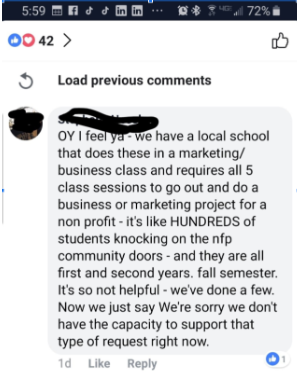Centering Community Voice in Service-Learning
After a summer & early fall hiatus, Service-Learning Librarian is back with a guest post from Dr. Julianne Gassman: Director, Office of Community Engagement and Professor, Recreation, Tourism & Nonprofit Leadership at University of Northern Iowa. We hope you appreciate Julianne's take on how to ensure our institutions center the community part of community engagement, with support from service-learning librarians.

Educating students to be engaged citizens, while not always so bluntly stated, is likely the goal of most, if not all, institutes of higher education. And if this goal is going to be realized, embedded into the experiences of students in colleges and universities must be opportunities for experiential learning in its many forms. In addition, the benefits of being engaged and volunteering is clear in the literature. The umbrella term that is often used in describing these opportunities for engagement is community engagement; however the list of terms that means community engagement or is related to community engagement is extensive. To name a few you have: engaged learning, service-learning, volunteering, community-based projects, service projects, and even terms such as internship and practicums have ‘community’ in how we think about them. These terms are used interchangeably and while there are differences in the technical meaning and practice of them, there is one element that remains most important - community voice. More pointedly, when a class, student organization, researcher, anyone from an institution of higher education is going to do ‘service-learning', or maybe better described as working in the community, the first and most important question is how will one decide what the community wants or needs, and whose voice is being heard that is informing the project or service? Service-learning librarians, or librarians in general are a likely source for this “community voice”.
Below are three strategies to consider when supporting a student or faculty member on some steps in designing a community engagement project and/or volunteering. This advice is not necessarily in chronological order of actions but rather is best combined for a holistic approach to understanding one’s community. First, getting information directly from the community partner is always a good starting point. Second, there are other sources of information to review such as community reports, websites, Census data, and other information about the partnering organization and the community. And a third resource is a communities’ local volunteer center or United Way, and if there is one, the institution’s office that leads community engagement work for the campus. The focus of efforts should be rooted in community need, uncovered in relationship building, while balancing advancing the mission of an organization with the learning objectives of a course (Stoecker & Tryon, 2009).
Let’s start with a direct source of information - the organization itself. Given that many faculty teach service-learning courses it is best practice that the faculty member appropriately engage with a partnering organization(s) to determine a project that will both advance the mission and goals of an organization as well as enhance the learning experience in the classroom. Appropriate actions when designing a service-learning course is contacting the organization directly and asking questions such as: Is there a project that you need help with that my students could support? Is there research that you need done to be able to best design a program? What needs do you have that are beyond your capacity? The intention of the conversation is to find a project that aligns with a course’s objectives. It is not recommended that students be given the directive to “go find a volunteer opportunity” for this class, but rather the faculty or instructor be more specific with the students. This will be further discussed below when discussing the importance of local volunteer centers and/or United Ways.
This direct source of information takes time, however. Faculty members should consider how they are building relationships with community organizations as a part, and embedded in their professional practice. Cold calling an organization to ask for a project for their students is transactional and likely too much work for a small organization that is possibly overwhelmed by daily operations. As a starting point, faculty, service-learning librarians, really anyone teaching at a higher education institution should attend town halls, go to volunteer fairs, attend local conferences so to connect with community members and organizations and build relationships that can be sustainable over time, rather than a one and done project that matters for a semester or two. This should be on-going and really a result of being an engaged citizen so to offer opportunities to students to be engaged citizens during their education.
The second piece of advice is that one must do their own research. Actually a faculty member should do some research on their own before deciding to engage with the community. And even after a partnering organization is selected and a project is determined, faculty, and more importantly the students, need to understand the context of the organization. Information such as what is the mission of the organization? Who does the organization serve? What are the demographics of the community? What is the history of the community? Why are some people being served by the organization and others are not? Students, faculty, or researchers should not engage in a partnership with a community organization or business without minimally doing their “homework” to have a basic understanding of the programs and work in a particular community. This is the area that service-learning librarians can take the lead. Offer to partner with faculty to lead students through research to answer the above listed questions. As an example at the University of Northern Iowa, the Service-Learning Librarian puts together this website for students as they prepare to volunteer at the local food bank.
A third piece of advice and, in addition to doing your own research, an excellent starting point is contacting a community’s local volunteer center. In some communities another organization such as the United Way may serve the function of a volunteer center - being often well connected and understanding the dynamics of a community well. A volunteer center’s mission is to connect citizens of the community to opportunities and volunteer needs of organizations in that community, therefore volunteer centers know the needs of the community as it is their job to know. In addition many college and university campuses have an office that leads the institution in their community engagement efforts. Contacting this office is also a great place to start when wanting to understand the needs and strengths of the community so to develop a project or conduct research based off of input from the community.
There are pitfalls to avoid and when giving advice and supporting others on campus it is important to assure the volunteer hours, projects, or research is both something an organization or community wants and even more important that those involved aren’t wasting their time. Let me give a commonplace example. A faculty member requires that each student volunteer a certain number of hours at a nonprofit organization that aligns with the course. Some suggestions may be given but for the most part students are on their own. As the semester progresses and the end of the semester nears, students start calling nonprofit organizations in the community asking if they can volunteer. The organizations are not prepared for these calls, but are inclined to be helpful to the student that seems a bit desperate to get their hours in. The organization comes up with a project that will be mildly helpful. In the end the student does not connect their volunteer time with any learning objectives in the course, staff at the organization spent time supporting the volunteer however the organization did not maximize the benefit of the volunteer hours as they were not prepared. Imagine this same scenario with the above listed steps in place and it is easy to conclude that adequate preparation is needed and a service-learning librarian can provide vital input and support faculty and students in this process.
Another example on what to avoid comes from a Nonprofit Happy Hour Facebook post. I share this comment often as it pointedly demonstrates the challenges when university students are sent into a community with little direction and no communication to the organizations in the community.

Librarians contacted for information by a faculty member, student, or researcher can lean into each of these steps guiding others to be sure that what they are planning to do, a service project, volunteer, research, is grounded and informed by the community they intend to serve or that will benefit the most from the work. In addition and complimentary to the advice listed above is for librarians to be personally involved in their community. Consider being involved in your children’s school, volunteering with an organization whose mission aligns with your values and motivates you to give back, or serve a nonprofit’s board of directors. When determining which of these are a good fit, contact your local volunteer center and assure you have a relationship with the director or volunteer coordinator at that organization. The more involved in a community the librarian, the more first hand knowledge one will have in directing and supporting others that want to be engaged in the community so to best align service projects and requirements of volunteering with the needs of the community.
It is likely readers of this blog are already connected to their communities in various volunteer capacities, however maybe you just moved to a community, or are just finding the time to become more involved. Here are some things you can do to get involved, or maybe expand your engagement beyond what you’ve done in the past.
- Attend campus / community events to expand your network
- Follow your organizations that are connector in your community (such as the volunteer center)
- Connect with Campus Compact or your local/regional support organization for your institution
It is important to note that community input on campus/community partnerships is an ongoing process. The needs and strengths of a community are constantly evolving and the more engaged those working in higher education institutions are in their communities, including service-learning librarians, or maybe most importantly service-learning librarians, the better the community will be served and the more courses can be enhanced by providing real--life practical application opportunities.
- Stoecker, R. & Tryon, E. A. (2009). The Unheard Voices: Community Organizations and Service-learning. Temple University Press.
All Service-Learning Articles by Month
- October 2023 (1)
- May 2023 (1)
- March 2023 (1)
- June 2022 (1)
- April 2022 (1)
- March 2022 (1)
- December 2021 (1)
- November 2021 (2)
- October 2021 (1)
- September 2021 (1)
- August 2021 (1)
- July 2021 (1)
- June 2021 (1)
- May 2021 (1)
- February 2021 (1)
- January 2021 (1)
- March 2018 (1)
- January 2018 (2)
- November 2017 (1)
- September 2016 (1)
- February 2014 (1)
- January 2014 (1)
- October 2013 (3)
- August 2013 (1)
- April 2013 (3)
- March 2013 (4)
- February 2013 (1)
- January 2013 (1)
- October 2012 (4)
- September 2012 (1)
- August 2012 (2)
- July 2012 (3)
- June 2012 (3)
- May 2012 (4)
- April 2012 (3)
- March 2012 (9)
- February 2012 (4)
- January 2012 (7)
- December 2011 (3)
- November 2011 (8)
- October 2011 (6)
- September 2011 (9)
- August 2011 (2)
- July 2011 (6)
- June 2011 (8)
- May 2011 (8)
- April 2011 (2)
- March 2011 (8)
- February 2011 (5)
- January 2011 (5)
- December 2010 (3)


